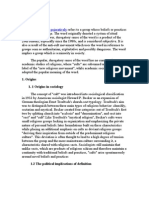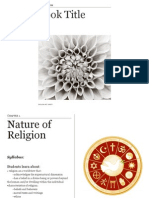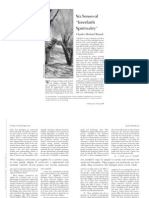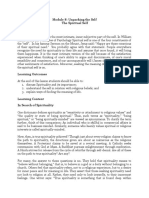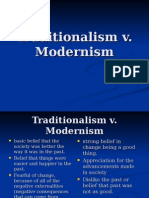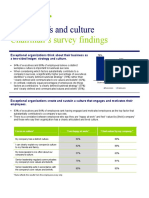0 ratings0% found this document useful (0 votes)
22 viewsKrippner 2006C
Krippner 2006C
Uploaded by
Ino MoxoThe document discusses the future of religion and spirituality. It predicts that religious institutions will continue transforming over time, with both growth of conservative religions and rise of new spiritual movements. While religion refers to organized belief systems, spirituality is a more personal pursuit of meaning beyond individual existence. Finding a spiritual foundation to address modern crises may occur through entheogens, progressive religious groups, or altered brain states from meditation. Overall, religion and spirituality appear hard-wired in humans and will likely continue evolving in diverse and unpredictable ways.
Copyright:
© All Rights Reserved
Available Formats
Download as PDF, TXT or read online from Scribd
Krippner 2006C
Krippner 2006C
Uploaded by
Ino Moxo0 ratings0% found this document useful (0 votes)
22 views15 pagesThe document discusses the future of religion and spirituality. It predicts that religious institutions will continue transforming over time, with both growth of conservative religions and rise of new spiritual movements. While religion refers to organized belief systems, spirituality is a more personal pursuit of meaning beyond individual existence. Finding a spiritual foundation to address modern crises may occur through entheogens, progressive religious groups, or altered brain states from meditation. Overall, religion and spirituality appear hard-wired in humans and will likely continue evolving in diverse and unpredictable ways.
Original Title
KRIPPNER 2006C
Copyright
© © All Rights Reserved
Available Formats
PDF, TXT or read online from Scribd
Share this document
Did you find this document useful?
Is this content inappropriate?
The document discusses the future of religion and spirituality. It predicts that religious institutions will continue transforming over time, with both growth of conservative religions and rise of new spiritual movements. While religion refers to organized belief systems, spirituality is a more personal pursuit of meaning beyond individual existence. Finding a spiritual foundation to address modern crises may occur through entheogens, progressive religious groups, or altered brain states from meditation. Overall, religion and spirituality appear hard-wired in humans and will likely continue evolving in diverse and unpredictable ways.
Copyright:
© All Rights Reserved
Available Formats
Download as PDF, TXT or read online from Scribd
Download as pdf or txt
0 ratings0% found this document useful (0 votes)
22 views15 pagesKrippner 2006C
Krippner 2006C
Uploaded by
Ino MoxoThe document discusses the future of religion and spirituality. It predicts that religious institutions will continue transforming over time, with both growth of conservative religions and rise of new spiritual movements. While religion refers to organized belief systems, spirituality is a more personal pursuit of meaning beyond individual existence. Finding a spiritual foundation to address modern crises may occur through entheogens, progressive religious groups, or altered brain states from meditation. Overall, religion and spirituality appear hard-wired in humans and will likely continue evolving in diverse and unpredictable ways.
Copyright:
© All Rights Reserved
Available Formats
Download as PDF, TXT or read online from Scribd
Download as pdf or txt
You are on page 1of 15
The Future of Religion
Stanley Krippner, Ph.D.
Alan Watts Professor of Psychology, Saybrook
Graduate School & Research Center
The etymology of the English language word
“religion” comes from a Latin verb meaning “to bind
together.” The word “yoga” originates from a similar
concept, namely “to yoke the human and the divine.” So
when we discuss religion, we are referring to a group of
people pursuing a connection with divinity, however the
group might conceptualize that term. When we think
about the future of religion, we are assuming that
religious institutions and ideas are capable of change,
even though many of them insist that they are the
recipients of a final revelation. However, students of
religion from Hans Kung to Huston Smith have
emphasized the transformations that have been a part of
religious traditions over the centuries. When predicting
the future of religion in the 1970s, scholars foresaw more
secularization, the decline of religious institutions, and the
explosion of “cults” and “sects.” They were partially right
and partially wrong. For example, a number of “new
religions” have appeared, including those using ayahuasca
as a sacrament; whether they should be called “sects” or
“cults” depends upon who is in charge of the labeling
process. Paradoxically, the world has become more
secular, and church attendance has declined in many
countries. On the other hand, conservative churches have
grown in membership, and some of the most prominent
players on the global scene are evangelical Protestants,
conventional Catholics, Hasidic Jews, Tibetan Buddhists,
Hindu nationalists, and Islamic fundamentalists. An
organization, the World Network of Religious Futurists
has been established to track these developments, many of
which are impacting the world in ways that were
unforeseen by students of religion in the 1970s.
When discussing religious and spiritual issues, I
have found it useful to distinguish the two terms. For me,
the word "religious" refers to the adherence to an
organized system of beliefs about the divine (something
deemed worthy of veneration and worship) and the
observance of rituals, rites, and requirements of that belief
system. “Spirituality,” on the other hand, can be thought
of as one's focus on, and/or reverence, openness, and
connectedness to some process or entity believed to be
beyond one's full understanding and/or individual
existence. Any rituals, behaviors, or beliefs that
accompany this process are internally generated rather
than reflective of an external authority or institution.
Albert Hofmann (2005) lamented that “a very
deep problem of our time is that we no longer have a
spiritual basis in our lives. The churches are no longer
convincing with their dogma. Yet people need a deep
spiritual foundation for their lives” (p. 50). In other
words, Hofmann also differentiates spirituality from
religion. He continued, “In the past, this [spiritual]
foundation was built on accepted religious creeds, which
people believed in. But today such beliefs have less
power. We can not believe things that we know are not
possible, that are not real. We must go on the basis of that
which we know—that which everyone can experience. On
this basis, we must find the entrance to the spiritual
world” (p. 50). Some people claim to have found this
entrance by means of LSD-type substances, sometimes
referred to as “entheogens.” I use the term “potential
entheogen” instead of “entheogen” because there is no
assurance that ingesting LSD, peyote, or mind-altering
mushrooms will bring about a spiritual experience
“bringing forth the God within,” as the term implies. The
variables of set and setting are more complex than the
substance itself, and to label these substances
“entheogens” simply posits a promise that is rarely
delivered.
The Network of Spiritual Progressives challenges
the idea that the Christian Right is the only segment of the
United States with a concerned interest in moral values as
they apply to society. According to its organizer, Rabbi
Michael Lerner, in great numbers Americans are
experiencing spiritual crises stemming from the practical
imperative faced by those in the modern workplace: to put
profit and power above everything else. This leaves love,
compassion, and a sense of meaning a distant second,
evoking suffering and spiritual pain (Catalfo, 2005). But
as Albert Hofmann (2005) observed, “Not all young
people are looking for money and power. Some are
looking for happiness and satisfaction born of the spiritual
world” (p. 50).
However, this search for spirit can be co-opted by
religious groups that divide rather than unite people.
Considerable attention has been given to the Muslim
terrorists who embark on jihads against infidels, including
those Muslims whose beliefs differ from theirs. In
addition, most of the forty ongoing wars in the world are
religious as well as political and territorial wars, ranging
from Chechnya and Kashmir to Sri Lanka and Sudan. But
the Religious Right in the United States also has used
divisive tactics in their attempt to capitalize on spiritual
pain and use it for their own purposes. Either overtly or
covertly, the Religious Right has identified several types
of “despised others” such as people of color, immigrants,
gays, Jews, and Muslims, as the sources of pain. Relieved
to having their deep-seated pain acknowledged and
concerned with the moral ground upon which they were
raising their families, many Americans have gravitated to
this message and to the extremist political agenda of the
Religious Right. However, that agenda conflicts with the
middle class’s own economic self-interest as well as the
fundamental ethical precepts of the great religious
traditions, such as healing the sick, comforting the
afflicted, sheltering the homeless, and celebrating the
interconnectedness of all life.
The Religious Right has been remarkably
successful because there was no other game in town.
However, every major progressive movement in
American history was driven by religious values:
abolition of slavery, women’s suffrage, child labor laws,
civil rights, etc. (Catalfo, 2005). The Network of Spiritual
Progressives is one of several groups in the United States
that refuses to allow the Religious Right to claim
hegemony regarding spiritual issues. Another group, the
Interfaith Alliance, is a cohort of progressive members of
the clergy and religious practitioners who work to
implement a dynamic agenda that reflects the moral and
ethical values needed in the 21st century. The
Center for Sexuality and Religion is also an interfaith
group, one that attempts to provide a moral and ethical
basis for sexual practices, but seeks an orientation that
reflects scientific data, humanistic values, and human
diversity. Integrative Spirituality describes itself as an
online spiritual consciousness community that enables
people to share their transformational experiences, to find
and communicate with “spirit mates,” and to participate in
surveys about spirituality. It is associated with the
Institute of Noetic Sciences and has a data base of 40,000
pages of wisdom from various spiritual traditions.
Religious and spiritual experiences appear to have
been hard-wired into humanity’s genetic legacy,
suggesting that they played an adaptive role during human
evolution. Religion, for example, fosters group discipline
and could have given hunter-gatherers an advantage for
survival as they grouped together both for worship and for
defense against their enemies. Spiritual experiences have
been investigated by Andrew Newberg and Eugene
d'Aquili (2001) who studied both Buddhist meditators and
Franciscan nuns. Using single photon emission computed
tomography (SPECT), they found that (when compared to
the baseline waking record) specific regions of their
participants' brains showed increased blood flow, while
other regions showed marked decreases during their
experiential reports. It is not unreasonable to suggest that
these meditators and nuns permanently altered their brains
in such a way to predispose themselves to spiritual
experiences through a neurological process referred to as
"kindling.” On the other hand, it is possible to have a
spiritual experience without the practice of contemplation
or prayer. The neuroscientist Michael Persinger (1987),
another researcher in this field, suggested that spiritual
experiences can be evoked spontaneously and
unexpectedly by mind-altering plants, unusual diets,
grief, fatigue, sensory deprivation, sensory over-
stimulation (e.g., piercing music) and various personal
dilemmas and stressors, all of which seem to be
associated with the brain’s temporal lobe lability.
For Newberg and d’Aquili, all spiritual and
religious experiences share several characteristics: a
progressive increase of unity over diversity, a progressive
sense of transcendence or otherworldliness, progressive
incorporation of an "observing Self" in the experience,
and a progressive increase of certainty in the objective
existence of what was experienced in the state (p. 243).
This body of research is sometimes referred to as
"neurotheology.” However, I think this term is a
misnomer. "Theology" is properly defined as the
methodological study of the nature and properties of
alleged deities (or of a single deity). Cognitive and
affective neuroscience have not provided, and have not
attempted to provide, this type of knowledge. The studies
just cited have focused on peoples' experiential reports,
the psychoneurological correlates of these reports, the
way these reports can be categorized, and the manner in
which these experiences might be evoked (through
contemplation, plants, electrical stimulation, and the
like). No claim can be made that these correlates indicate
causation; it would be both reductionistic and premature
to claim that brain activity "causes" a spiritual experience.
The question can be asked, "Is a naturally-occurring
spiritual experience more valid than an induced
experience?" However, such a question assumes that the
"validity" of "naturally-occurring" spiritual experiences
has been established. However, investigators have not
even agreed on the questions that would need to be asked
to establish such validity.
On the other hand, there are enough data available
to investigate the application of these findings. Evoked
spiritual experiences could address existential issues such
as finding meaning in life. A review of one's spiritual
experiences could provide a means of establishing one's
"personal mythology" or "personal theology." In addition,
spiritual experiences evoked by LSD-type substances (see
Pahnke, 1966) have been utilized therapeutically with
terminal cancer patients, with combat veterans suffering
from post-traumatic stress disorder, and with alcoholics
and drug addicts.
In the meantime, if religious and spiritual
experiences are part of humanity’s genetic heritage, both
social scientists and philosophers need to realize that
“God won’t go away,” to use the title of Newberg and
d’Aquili’s book. The philosopher Cornell West (2002)
has argued for a combination of Christian and Marxist
perspectives for a “revolutionary Christianity.” West’s
writings have been seminal in helping me formulate my
suggestions for the ideal religion of the future, a religion
(or consortium of religions) that needs to incorporate at
least four elements.
These religions needs to be transcendental,
acknowledging the existence of some process or entity
worthy of respect and reverence, whether it is named God,
the Goddess, the Eternal Tao, the Ground of Being, or
something else. As Albert Hofmann remarked, “The
material world is only the manifestation of the spiritual
world”; the so-called “perennial philosophy” that can be
found in all religions suggests that the discovery of the
spiritual world impacts and changes people’s behavior
and attitudes in positive ways, and that this transformation
is both profound and long-lasting. Long before the
development of contemporary religions, indigenous
cultural groups had developed a repertoire of plants,
chants, rhythmic music and movement, self-regulatory
practices, and voluntary shifts in attentional states to
produce spiritual and religious experiences. The case can
be made that religion was more experiential in those
groups than in contemporary societies, and that peoples’
contact with transcendent realms was more frequent than
it has been in modern times. As Hofmann has observed,
“Young people are looking for meaningful experiences…,
for [something] that is the opposite of the material world.”
Secondly, the religions of the future need to be
embodied; they need to accept and cultivate bodily health,
sensual pleasure, and sexual diversity. Religious
institutions have a centuries-old record of sexism,
homophobia, and rage against the body. This is a legacy
in need of radical change if religious institutions are to be
viable in a world suffering from an AIDS pandemic, as
well as child abuse, wife battering, the murder of one’s
own family members in the name of “honor,” and the
persecution of gays, lesbians, bisexuals, and
transgendered individuals. Insofar as AIDS prevention is
concerned, most of those representing organized religion
have been part of the problem. Too many churches,
temples, and mosques either refuse to disseminate
information about life-saving sexual practices, or spread
information that is distorted, biased, or falsified.
Regarding the role of women, mainstream religion has a
record of opposition to their participation in church
governance and leadership, and has even denied their
right to control their own bodies. Although contemporary
religions did not initiate the practice of cliterectomy, they
have been slow in opposing this mutilation of a vital
female organ. Not only have most mainstream religions
condemned a woman’s right to abortion, but family
planning, birth control, and even feminine hygiene have
been discouraged or forbidden.
Although some traditions advocate celibacy as a
route to higher consciousness, other traditions see sexual
activity as a venerable vehicle for attaining mystical
insights. Jenny Wade (2004), a transpersonal
psychologist, interviewed nearly 100 people with various
sexual orientations and from several religious
backgrounds, constructing a typology of mystical,
spiritual, or transcendent experiences during sex. Her
typology was based on a model developed by the
psychiatrist Stanislav Grof (1998) who analyzed reports
from thousands of clients participating in LSD-facilitated
psychotherapy and/or so-called "holotropic breathwork."
Wade reported that her research participants' transcendent
experiences resembled those of Grof's group, especially in
such areas as "ecstatic union" and the movement of
"kundalini energy." Indeed, Newberg and d’Aquili (2001)
posited that romantic love, as characterized by the phrase,
"It's bigger than both of us," may be a transitional phase
between aesthetic and religious experience, a signpost on
the way to a state they call "absolute unitary being," a
state in which the boundaries of entities within the world
disappear and the self-other dichotomy is obliterated. It is
equated with the "void," with "nirvana," and/or "the
experience of God" (p. 236).
The third hallmark of future religions is that they
need to be socially relevant and liberating, opposing
tyranny and social injustice. Religions of the future need
to afford opportunities for sharing, compassion,
peacemaking, and the manifestation of love. This love
should be extended to the natural environment, a resource
that is threatened by global warming, pollution,
desertification, and the destruction of the rain forests.
Albert Hofmann has advised people “to go out into the
countryside” because “such places are of the world of
nature, to which we fundamentally belong. It is the circle
of life, of which we are an integral part.” But the
meadows and woods extolled by Hofmann are being
threatened by human insensitivity and greed. This misuse
of technology, as Hofmann has reminded us, “could not
have emerged from a consciousness of reality in which
human beings are not separated from the environment but
rather exist as part of living nature.”
Finally, the religions of the future needs to work
with science and not in opposition to the scientific
method, scientifically gathered data, and scientifically
conceived theories. Science and religion ask different
questions; science inquires as to “how?” while religion
queries “why?” So-called “scientific creationism” is an
oxymoron, one that is dogmatic rather than scientific and
that denies the beauty of Darwinian Theory as well as its
remaining mysteries. Albert Hofmann adds that “We are
at a phase of human development where we have
accumulated an enormous amount of knowledge through
scientific research in the material world. This is important
knowledge, but it must be integrated.” For Hofmann, “the
different forms of religion are no longer adequate. They
are simply words, words, words, without the direct
experience of what it is the words represent.” But science
that is not integrated into our lives can end up simply as
“words, words, words” as well. Future religions can assist
people to extract meaning from scientific data, balancing
what Hofmann calls “these two sides of our lives.”
In other words, the new religions will be a
dramatic contrast to the old religions that insist that an
idea is either true and revealed or false and heretical.
Science has always been an incomplete project; outmoded
theories are replaced by new data and novel hypotheses
are put forward in attempts to explain fresh discoveries.
The religions of the future also need to admit that they are
incomplete processes, but represent a quest that is
necessary to inspire and provide consolation for the
human species, especially during times when inspiration
and hope are rare commodities.
What role will LSD-like substances play in the
religions of the future? Peyote, mushrooms, and
ayahuasca are currently utilized as sacraments in both old
and new religious institutions. However, Albert Hofmann
reminds us that “it is quite possible to have [spiritual]
experiences without drugs.” With or without the use of
LSD-type substances, religions that are both transcendent
and embodied, both socially conscious and scientifically
informed, have the potential to help mend the torn
cultures that already devastate the landscape of this new
century.
References
Catalfo, P. (2005, Winter). A new bottom line. Tricycle,
25-26.
Fox, M. (2006). A new reformation: Creation spirituality
and the transformation of Christianity. Rochester, VT:
Inner Traditions.
Grof, S. (1998). The cosmic game: Explorations of the
frontiers of human consciousness. Albany: State
University of New York Press.
Hofmann, A. (2005). From molecules to mystery:
Psychedelic science, the natural world, and beyond. In R.
Walsh & C. Grob (Eds.), Higher wisdom: Eminent elders
explore the continuing impact of psychedelics (pp. 47-53).
Albany: State University of New York Press.
Hofmann, A. (1980). LSD: My problem child. New York:
McGraw-Hill.
Newberg, A., & d'Aquili, E. (2001). Why God won't go
away. New York: Ballantine.
Pahnke, W.N. (1966). Drugs and mysticism. International
Journal of Parapsychology, 8, 295-314.
Persinger, M.A. (1987). Neurophysiological bases of god
beliefs. New York: Praeger.
Rorty, R., & Vattimo, G. (2005). The future of religion.
New York: Columbia University Press.
Wade, J. (2004). Transcendent sex: When lovemaking
opens the veil. New York: Paraview Pocket Books.
West, C. (2002). Prophesy deliverance: An Afro-
American revolutionary Christianity (anniversary
edition). Westminster, England: John Knox Press.
This paper was prepared for presentation at LSD: Problem
Child and Wonder Drug, An International Symposium on
the Occasion of the 100th Birthday of Albert Hofmann,
13-15 January, Basel, Switzerland. Its preparation was
supported by the Chair for the Study of Consciousness,
Saybrook Graduate School and Research Center, San
Francisco, California, U.S.A.
You might also like
- HRT 3m - Aboriginal Spirituality Unit PlanDocument83 pagesHRT 3m - Aboriginal Spirituality Unit Planapi-400771040No ratings yet
- Religious Education For TavongaDocument102 pagesReligious Education For TavongaTlotlo carvin NthokgoNo ratings yet
- Understanding World Religions in 15 Minutes a DayFrom EverandUnderstanding World Religions in 15 Minutes a DayRating: 4.5 out of 5 stars4.5/5 (6)
- Comparative Study of ReligionDocument18 pagesComparative Study of ReligionJunior MirandaNo ratings yet
- REDocument104 pagesREmonamatiludo17No ratings yet
- Fifth EditionDocument94 pagesFifth EditionkatkaisaraNo ratings yet
- Religious Education NotesDocument101 pagesReligious Education NotestsholofelobapingNo ratings yet
- Religious Education Notes-1Document100 pagesReligious Education Notes-1palesambalie828No ratings yet
- DAH - Expert Project_ Religion - FINALDocument10 pagesDAH - Expert Project_ Religion - FINALdylanaersNo ratings yet
- I.E 2 Semifinal ModuleDocument7 pagesI.E 2 Semifinal ModuleMattNo ratings yet
- Religious Education Notes-1Document100 pagesReligious Education Notes-1hardenhardlessNo ratings yet
- Sociology Literature ReviewDocument3 pagesSociology Literature ReviewSmriti SharmaNo ratings yet
- Albert Einstein: What Is Religion and Belief?Document2 pagesAlbert Einstein: What Is Religion and Belief?Wilfredz Masong-Bayer YonsonNo ratings yet
- Ralph HoodDocument43 pagesRalph HoodrikylatNo ratings yet
- Religion and The Search For Ultimate Meaning Learning ObjectivesDocument2 pagesReligion and The Search For Ultimate Meaning Learning ObjectivesEmon MijasNo ratings yet
- Position Comparison - Why All Religions Are Ultimately The SameDocument6 pagesPosition Comparison - Why All Religions Are Ultimately The Sameapi-338165809No ratings yet
- (Special Notes For Class Discussion Taken From The Book "Initium Fidei" (REAP) ) Lesson 2: A Conversation Between: Spirituality and TheologyDocument5 pages(Special Notes For Class Discussion Taken From The Book "Initium Fidei" (REAP) ) Lesson 2: A Conversation Between: Spirituality and TheologyGerald Niño ElardoNo ratings yet
- The Psychology of Religion and Spirituality Yes and NoDocument15 pagesThe Psychology of Religion and Spirituality Yes and NoCarolina ZimmerNo ratings yet
- Spiritual Care in our Multifaith World: A Primer on Practice and TheoryFrom EverandSpiritual Care in our Multifaith World: A Primer on Practice and TheoryNo ratings yet
- INTRODUCTION TO WORLD RELIGION Topic 1Document24 pagesINTRODUCTION TO WORLD RELIGION Topic 1Æ JOHN RAISE ÆNo ratings yet
- Pejoratively: 1. Origins 1. 1 Origins in SociologyDocument16 pagesPejoratively: 1. Origins 1. 1 Origins in SociologyMark 馬可 SantiagoNo ratings yet
- TCW - Chapter 11Document14 pagesTCW - Chapter 11Yna SarrondoNo ratings yet
- Worldview and CultureDocument11 pagesWorldview and Culturehimi oumaimaNo ratings yet
- DocumentDocument5 pagesDocumenthauwau yusufNo ratings yet
- By Human Hands: The Construction and Role of Religion Within SocietyDocument24 pagesBy Human Hands: The Construction and Role of Religion Within Societyredhawk23No ratings yet
- 05 Chapter 1Document68 pages05 Chapter 1BhagirathNo ratings yet
- Philosophy of Religion, Britannica ArticleDocument33 pagesPhilosophy of Religion, Britannica ArticleacademicDNo ratings yet
- Religion & Spirituality in MHDocument18 pagesReligion & Spirituality in MHspurthi_16No ratings yet
- ACTIVITY 3-Collaborative LearningDocument9 pagesACTIVITY 3-Collaborative LearningOlga LuciaNo ratings yet
- RELIGIOUS STUDIES 2 Appendecis 1 &2Document12 pagesRELIGIOUS STUDIES 2 Appendecis 1 &2Arnold John B BastilladaNo ratings yet
- Religion ChapterText Fall2021 20210906 Ub02c8Document34 pagesReligion ChapterText Fall2021 20210906 Ub02c8Ryma UzairNo ratings yet
- Uts Chap 9 PDFDocument12 pagesUts Chap 9 PDFAngel SantiagoNo ratings yet
- Theology 110 Presentation of IdeasDocument7 pagesTheology 110 Presentation of IdeasTater ToataNo ratings yet
- Ignou Books Tanqeed o BalaghatDocument10 pagesIgnou Books Tanqeed o BalaghatLOCAL VILLAGERNo ratings yet
- Local Media4758723238205147632Document66 pagesLocal Media4758723238205147632Reymar LaganosaNo ratings yet
- Yr 11 Sor Preliminary Ibook 2015Document27 pagesYr 11 Sor Preliminary Ibook 2015jobinNo ratings yet
- ContempDocument10 pagesContempMarrianne ShaneNo ratings yet
- Influences of ReligionDocument4 pagesInfluences of ReligionRia LucenaNo ratings yet
- The Arc of Spirituality: The Western Love Affair with GodFrom EverandThe Arc of Spirituality: The Western Love Affair with GodNo ratings yet
- Chapter 9. The Spiritual SelfDocument12 pagesChapter 9. The Spiritual SelfAna Lorraine BaldozNo ratings yet
- Advantages and Disadvantages of ReligionDocument5 pagesAdvantages and Disadvantages of ReligionOana MicăNo ratings yet
- Religion, Economy, PoliticsDocument13 pagesReligion, Economy, Politicshunaiza khanNo ratings yet
- Toward Interfaith Harmony: Why People Believe or Not, And Where Differences Take Us NextFrom EverandToward Interfaith Harmony: Why People Believe or Not, And Where Differences Take Us NextNo ratings yet
- Scientology and Religion by Christiaan VonckDocument10 pagesScientology and Religion by Christiaan Voncksirjsslut100% (1)
- Lecture 11Document35 pagesLecture 11AbdirahmanNo ratings yet
- Module 8Document14 pagesModule 8kayedacayo5No ratings yet
- Six Senses of "Interfaith Spirituality": Charles Michael BurackDocument4 pagesSix Senses of "Interfaith Spirituality": Charles Michael BurackCharlesMichaelBurackNo ratings yet
- The Sacred and The Search For SignificanceDocument23 pagesThe Sacred and The Search For SignificanceSuela DibraNo ratings yet
- Spirituality Without Sin and Salvation: Psychology and the New Paradigm for ReligionFrom EverandSpirituality Without Sin and Salvation: Psychology and the New Paradigm for ReligionNo ratings yet
- On Pilgrimage With Abraham How A Patriarch Leads Us in Formation in FaithDocument20 pagesOn Pilgrimage With Abraham How A Patriarch Leads Us in Formation in FaithNguyen MinhNo ratings yet
- Module 3 - Understanding Culture, Society and PoliticsDocument7 pagesModule 3 - Understanding Culture, Society and PoliticsHelenNo ratings yet
- Spiritual Self 0Document32 pagesSpiritual Self 0alberthillaryeNo ratings yet
- UTS Bsed The Spiritual SelfDocument8 pagesUTS Bsed The Spiritual SelfCorine ColorNo ratings yet
- Relig First-Year AllDocument222 pagesRelig First-Year AllDanuma GyiNo ratings yet
- CatalystofreligionDocument8 pagesCatalystofreligionapi-279621217No ratings yet
- Iwrbs 1Document11 pagesIwrbs 1Kim ComposoNo ratings yet
- 2023 Assesment of K&A of Colostrum FeedingDocument9 pages2023 Assesment of K&A of Colostrum Feedingalelgnmarkos357No ratings yet
- Module 8: Unpacking The Self The Spiritual SelfDocument13 pagesModule 8: Unpacking The Self The Spiritual SelfNeil Paul Baquiran100% (1)
- Thesis For World Religion PaperDocument5 pagesThesis For World Religion Paperdebradavisneworleans100% (3)
- Answer 1Document6 pagesAnswer 1geofreyNo ratings yet
- Beals 1935Document124 pagesBeals 1935Ino MoxoNo ratings yet
- PUMA Kicks Up Order Rate 7% With Insights From Google Analytics and VigetDocument3 pagesPUMA Kicks Up Order Rate 7% With Insights From Google Analytics and VigetIno MoxoNo ratings yet
- NissanDocument2 pagesNissanIno MoxoNo ratings yet
- Guide Small Business Email MailchimpDocument23 pagesGuide Small Business Email MailchimpIno MoxoNo ratings yet
- Reviewed Work(s) :: Review: The Scientific Reception of CastanedaDocument5 pagesReviewed Work(s) :: Review: The Scientific Reception of CastanedaIno MoxoNo ratings yet
- Discussion and Correspondence: WE NothingDocument7 pagesDiscussion and Correspondence: WE NothingIno MoxoNo ratings yet
- On Netnography: Initial Reflections On Consumer Research Investigations of CybercultureDocument21 pagesOn Netnography: Initial Reflections On Consumer Research Investigations of CybercultureIno MoxoNo ratings yet
- The Dark Side of Social Media A Reality Becoming MDocument17 pagesThe Dark Side of Social Media A Reality Becoming MIno MoxoNo ratings yet
- Field Behind Round1 RevDocument42 pagesField Behind Round1 RevIno MoxoNo ratings yet
- Approaches To The Study of Hypnotic Dreams: Charles T. TartDocument1 pageApproaches To The Study of Hypnotic Dreams: Charles T. TartIno MoxoNo ratings yet
- Tart 1978aDocument8 pagesTart 1978aIno MoxoNo ratings yet
- Psychophysiological Study of Out-of-the-Body Experiences in A Selected SubjectDocument7 pagesPsychophysiological Study of Out-of-the-Body Experiences in A Selected SubjectIno MoxoNo ratings yet
- Tart 1989Document4 pagesTart 1989Ino MoxoNo ratings yet
- Toward Conscious Control of Psi Through Immediate Feedback Training: Some Considerations of Internal ProcessesDocument9 pagesToward Conscious Control of Psi Through Immediate Feedback Training: Some Considerations of Internal ProcessesIno MoxoNo ratings yet
- Maynard Moody Musheno State Agent-Citizen AgentDocument30 pagesMaynard Moody Musheno State Agent-Citizen AgentElenaNo ratings yet
- Heavens Gate by Mark W. MuesseDocument4 pagesHeavens Gate by Mark W. MuessesirjsslutNo ratings yet
- Trance Forms: A Theory of Performed States of ConsciousnessDocument320 pagesTrance Forms: A Theory of Performed States of ConsciousnessRonaldo Morelos100% (3)
- Coaching Knowledge Assessment (CKA) For ICFDocument15 pagesCoaching Knowledge Assessment (CKA) For ICFaeon blissNo ratings yet
- AMORC - Mansions of The Soul (1930) PDFDocument344 pagesAMORC - Mansions of The Soul (1930) PDFsybilla_89100% (7)
- Intro. To Political TheoriesDocument3 pagesIntro. To Political TheoriesAilene SimanganNo ratings yet
- Theistic and Animistic Beliefs of The SuDocument11 pagesTheistic and Animistic Beliefs of The SuYeshael SukkunokamiNo ratings yet
- English ReviewerDocument3 pagesEnglish ReviewerKurt Dela PenaNo ratings yet
- Coaching With Meaning and Spiri - Hyson, PeterDocument254 pagesCoaching With Meaning and Spiri - Hyson, PeterPendar FazelNo ratings yet
- Case Study 1Document5 pagesCase Study 1Trang Pham50% (2)
- Plant-2004-Journal of Religious EthicsDocument28 pagesPlant-2004-Journal of Religious EthicsSabinaAvramNo ratings yet
- Order For Masks by Virginia MorenoDocument3 pagesOrder For Masks by Virginia MorenoJason MontañaNo ratings yet
- Psych AssDocument2 pagesPsych AssBagi RacelisNo ratings yet
- Adult Development and LeadershipDocument28 pagesAdult Development and LeadershipUsama dawoudNo ratings yet
- 2008-01-12 San Diego CA TranscriptDocument21 pages2008-01-12 San Diego CA Transcriptonakojasetamacku100% (1)
- Political Ideas and Remedies Appearing in Bertrand Russell's "Ideas That Have Harmed Mankind"Document2 pagesPolitical Ideas and Remedies Appearing in Bertrand Russell's "Ideas That Have Harmed Mankind"HurmatM100% (1)
- Notes On Ideology and UtopiaDocument11 pagesNotes On Ideology and UtopiaAaron MajekNo ratings yet
- Overcome Barriers of Listening1Document10 pagesOvercome Barriers of Listening1AnguNo ratings yet
- CPT SA IND TX Manual 2012Document82 pagesCPT SA IND TX Manual 2012MalenaBellinaNo ratings yet
- Traditionalism V ModernismDocument9 pagesTraditionalism V ModernismChenniga RajuNo ratings yet
- Factors Influencing Tourists' Destination Image Formation Process:-A Literature ReviewDocument6 pagesFactors Influencing Tourists' Destination Image Formation Process:-A Literature ReviewMANPREETNo ratings yet
- Goal Setting and MotivationDocument111 pagesGoal Setting and MotivationBeowulf Odin Son100% (1)
- Human-Wildlife Conflict Management: A Practitioners' GuideDocument52 pagesHuman-Wildlife Conflict Management: A Practitioners' GuideFahad ShahNo ratings yet
- 13 - ABC of Risk Culture - Hillson PaperDocument9 pages13 - ABC of Risk Culture - Hillson Paperimran jamilNo ratings yet
- Core Beliefs and Culture: Chairman's Survey FindingsDocument3 pagesCore Beliefs and Culture: Chairman's Survey Findingssakshi tomarNo ratings yet
- DLP - PPG W 2Document8 pagesDLP - PPG W 2Abegail AlcoberNo ratings yet
- Essay Sample On Coaching PhilosophyDocument9 pagesEssay Sample On Coaching PhilosophyInstant Assignment HelpNo ratings yet
- Wallis 1970 The Impact of Time Perspectives On The Dynamics of ChangeDocument8 pagesWallis 1970 The Impact of Time Perspectives On The Dynamics of ChangeMsq JuliaNo ratings yet
- Normativity As The Key To Objectivity An Exploration of Robert Brandom S Articulating ReasonsDocument20 pagesNormativity As The Key To Objectivity An Exploration of Robert Brandom S Articulating ReasonsMilan MatejicNo ratings yet





















